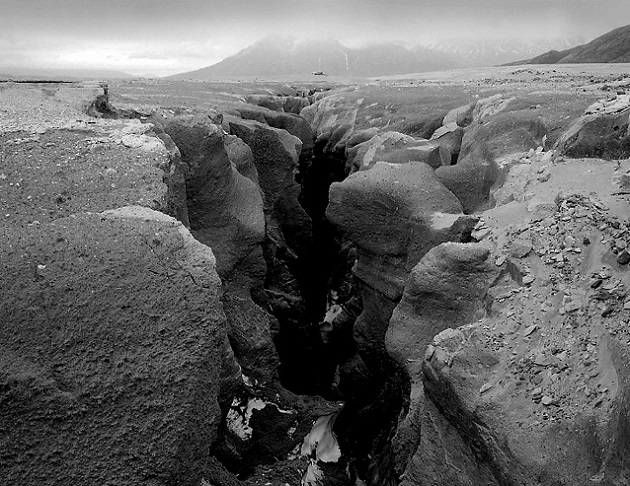
Photo courtesy of Gary Freeburg
The story of the Valley of Ten Thousand Smokes begins on June 6, 1912, with the largest volcanic eruption recorded on Earth during the twentieth century. The eruption took place on the Alaska Peninsula 100 miles (161 km) west of Kodiak, Alaska. In three days, a new volcano, Novarupta, was born. This volcano ejected five cubic miles (21 km3) of ash and debris into the atmosphere, with heavier deposits filling an adjacent 44 square mile (114 km2) valley in depths up to 1,000 feet (305 m). The dense, superheated waves of magmatic spray coming from the volcano incinerated all living organisms in their path, leaving a hot bed of igneous material that, when mixed with water from the surrounding glaciers and snowfields, produced thousands of steam vents known as fumaroles.
Robert F. Griggs, Director of the National Geographic Society Katmai expeditions of 1915, 1916, 1917, and 1919, was the first person to discover the steaming valley on July 31, 1916. He ascended Katmai Pass, observed his surround-ings, and wrote:

Photo courtesy of Gary Freeburg
The sight that flashed into view as we surmounted the hillock was one of the most amazing visions ever beheld by mortal eye. The whole valley as far as the eye could reach was full of hundreds, no thousands – literally, tens of thousands – of smokes curling up from its fissured floor. The first glance was enough to assure us that we had stumbled into another Yellowstone Park – unseen and unsuspected by white man and native alike until this hour. I tried to “keep my head” and observe carefully, yet I exposed two films from my one precious roll in trying for pictures that I should have known were impossible. It was as though all the steam engines in the world, assembled together, had popped their safety valves at once and were letting off surplus steam in concert. (Griggs 1918)
I have visited the Valley of Ten Thousand Smokes five times between 2000 and 2011. The smokes (fumaroles) that Griggs talks about are mostly gone, that element of visual and volcanic activity has largely ceased. As I walked in the footsteps of Griggs, I imagined the deafening noise and incredible physical forces of the 1912 explosion and contrast that historic event with what I now perceive as a monumental statement of sublime beauty and geological silence.
Being completely alone in the Valley and its 44 square miles was a fulfilling experience. Like Griggs and his companions a century ago, I created these photographs to document and express what I have come to know of this special place on Earth, a landscape that nurtures my con-templative spirit and personal desire to be in wild places. I hope that as you review this issue of Alaska Park Science, that you will also gain a sense of the awe and respect that Robert Griggs and so many others have felt when experi-encing the Valley of Ten Thousand Smokes.
Information about Gary Freeburg’s book, The Valley of 10,000 Smokes: Revisiting the Alaskan Sublime, and more images can be found at George F. Thompson Publishing.
References
Griggs, R.F. 1918. The Valley of Ten Thousand Smokes: An Account of the Discovery and Exploration of the Most Wonderful Volcanic Region in the World. The National Geographic Magazine 33(2): 115-169.
Part of a series of articles titled Alaska Park Science - Volume 11 Issue 1: Volcanoes of Katmai and the Alaska Peninsula.
Last updated: June 14, 2016
